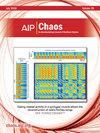非线性随机分数系统在广义SEIR模型中的应用。
IF 3.2
2区 数学
Q1 MATHEMATICS, APPLIED
引用次数: 0
摘要
在本文中,我们成功地推广了SEIR(易感、暴露、感染和恢复)模型,以解释随机和间歇性的疾病传播实例。该模型解释了在特定时期,特别是季节性疾病传播的可能性增加。进一步,我们利用非紧性度量来研究保证该模型至少有一个解的必要条件。在此之后,我们引入了一种新的方法来检验收敛性,之后我们应用所提出的数值方法来研究实际的例子。本文章由计算机程序翻译,如有差异,请以英文原文为准。
Application of nonlinear stochastic fractional systems in the generalized SEIR model.
In this article, we successfully generalize the SEIR (Susceptible, Exposed, Infected, and Recovered) model to account for random and intermittent instances of disease transmission. This model explains the increased probability of disease transmission during specific periods, particularly for seasonal illnesses. Furthermore, we investigate the conditions necessary to ensure at least one solution for this model by employing the measure of noncompactness. Following this, we introduce a new approach that examines convergence, after which we apply the proposed numerical method to study practical examples.
求助全文
通过发布文献求助,成功后即可免费获取论文全文。
去求助
来源期刊

Chaos
物理-物理:数学物理
CiteScore
5.20
自引率
13.80%
发文量
448
审稿时长
2.3 months
期刊介绍:
Chaos: An Interdisciplinary Journal of Nonlinear Science is a peer-reviewed journal devoted to increasing the understanding of nonlinear phenomena and describing the manifestations in a manner comprehensible to researchers from a broad spectrum of disciplines.
 求助内容:
求助内容: 应助结果提醒方式:
应助结果提醒方式:


